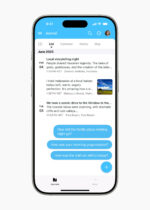The latest mobile application-development design trend favors a “flat” UI. Developers are being told that skeuomorphism is out and flat is in.
The Merriam-Webster definition of skeuomorph is an ornament or design representing a utensil or implement. In other words, it’s a digital object made to resemble a real-life object. They’re used to make the new digital versions look like the old, familiar ones. Mobile applications have always used skeuomorphs to try to make the digital experience more closely resemble that of real life.
In Windows Phone 8, Microsoft moved away from skeuomorphism in an attempt to make mobile apps appear “authentically digital.” And in their upcoming iOS 7 release this fall, Apple is shifting their UI design from skeuomorphic to a flat design.
Following the lead of companies such as Microsoft and Apple, more and more mobile app development tool providers are also moving away from skeuomorphism in favor of flat. Some tool providers say it will improve app performance and save on battery life, the rationale being that flat mobile apps will take less time to perform actions and load in all the necessary visual effects.
One of the most popular arguments in favor of skeuomorphic design, though, is that it makes it easier for users familiar with the original device—a rotary phone, or a Rolodex—to use the digital emulation of it. Since their earliest days, mobile apps have been created to look as “real” as possible, incorporating elements that closely resembled real-life objects. Heck, that’s why mobile applications were cool in the first place.
We think this is where mobile applications got their fanbases and why users will just not like the new flat UIs. No matter how old or young you are, as a user, you want a great user experience when using your cellphone or tablet. We think skeuomorphism is not outdated; it’s still an important UI design trend. In mobile, after all, the user experience is key. A mobile application’s UI has a direct effect on user experience.
You can’t go backwards in design, removing all the pleasing visual aesthetics in mobile apps to which users are accustomed. Flat will not be visually appealing. Flat will look boring in mobile apps. Flat is a step back. The current “flat” craze will, ultimately, fall flat.
#!
WebRTC: Still about the codec
In speaking with the World Wide Web Consortium about HTML5 and WebRTC, the issue of the video codec keeps coming up. Should the group accept VP8, the Google-backed codec, or H.264, which Microsoft, Apple and many others already have implemented, but comes with a licensing fee?
As of today, WebRTC specifies only one codec: VP8. A big part of that reason, WebRTC specification editor Dan Burnett told SD Times in this issue’s cover story, is ubiquity. Only that which can be implemented inexpensively will become nearly universally used.
So the issue for the W3C becomes this: What is the least amount it will require of the codecs to guarantee interoperability? Currently, there is no way to do a conference call between browsers using different codecs.
So the W3C finds itself in a bit of a spot. It doesn’t wish to alienate those using the H.264 codec, while it acknowledges through the WebRTC definition that the VP8 codec is the logical choice for ubiquity.
The W3C should plant its flag in the VP8 ground and say this is the codec the specification has chosen. If you want to have a standard WebRTC browser, this is how you’ve got to go. And while hardware manufacturers such as Apple might balk at first because of its investment with H.264, we’re confident all will ultimately get on board.
Apple’s security woes teach us all
Apple’s developer site was not hacked by some international conspiracy, nor was it broken by a malicious former employee. It was taken down by a bug in Apache Struts that allowed remote code execution on their servers.
The thing to note here is that the exploit in Struts was made public on June 24. Apple reportedly was informed of the problem back on May 10. The actual patch for this exploit was released on July 16, and Apple’s site was hacked shortly thereafter.
For the rest of the world, this means that you need to be up to date on all of the exploits in your stack. Proper coding procedures don’t mean a thing if a remotely exploitable bug is lying in wait inside your stack. If you find out that something in your stack is vulnerable, you really need to drop everything and patch ASAP. In a world with more than a billion people online, there is now zero time between when an exploit hits BugTraq and when it is in use in the wild. Plan accordingly.





